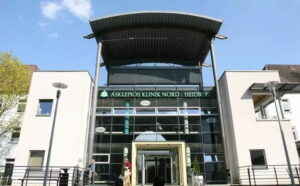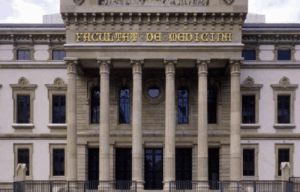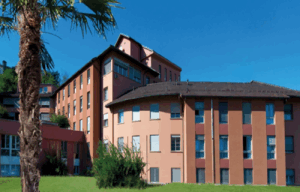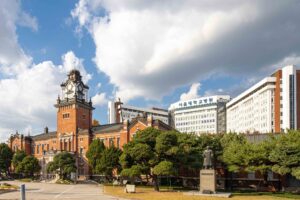Orthopedics and traumatology
Just a few years ago, conditions such as intervertebral hernias, osteochondrosis, and arthrosis could lead to disability and prevent individuals from living full lives. Today, thanks to modern medical achievements, most of these conditions can be successfully treated.
Orthopedics and traumatology focus on the diagnosis, treatment, and prevention of musculoskeletal disorders, as well as the restoration of bodily functions following injuries or degenerative changes. Innovative treatment methods allow patients to fully regain mobility, leaving pain and limitations behind.
Who needs to see an orthopedic surgeon
- Individuals with chronic joint, spine, or bone pain that persists over a long period of time
- Patients experiencing limited mobility or difficulty performing everyday physical activities such as walking or lifting objects
- Patients with musculoskeletal injuries (fractures, dislocations, ligament and tendon tears)
- Individuals with skeletal, joint, or spinal deformities (e.g., scoliosis or kyphosis)
- Patients suspected of having degenerative diseases such as osteoarthritis or osteoporosis
- Patients with recurrent inflammatory joint processes typical for rheumatic diseases
Common procedures in global orthopedics and traumatology
In global orthopedic and trauma care, diagnostics play a crucial role in identifying the exact nature and progression of diseases. Modern diagnostic procedures help detect pathological changes at the earliest stages, significantly increasing the effectiveness of the treatment.
- Magnetic resonance imaging (MRI). One of the most informative diagnostic methods, used to visualize soft tissues, including cartilage, ligaments, tendons, and muscles. MRI allows for detailed examination of intervertebral discs and joints, helping detect injuries such as hernias or ligament tears.
- Computed tomography (CT). This method provides detailed images of bones and joints. CT is widely used to assess the extent of bone damage in trauma cases and to plan complex surgical procedures, such as joint replacement.
- X-ray imaging (radiography). A classic diagnostic tool that evaluates bone condition, detects fractures, osteophytes, and degenerative joint changes. Radiography is often used in combination with other methods for a comprehensive assessment.
- Ultrasound examination (US). Used to assess soft tissues (tendons and ligaments) and diagnose inflammatory joint conditions. This accessible and non-invasive method is often employed for dynamic monitoring of joint health.
- Bone densitometry. A specialized examination used to assess bone mineral density. This method is essential for diagnosing osteoporosis and evaluating fracture risk, particularly in elderly patients.
- Arthroscopy. A diagnostic procedure in which the doctor can directly visualize the internal structures of a joint and determine the exact nature of any damage, facilitating detailed treatment planning.
Where to seek expert medical care
| Coxarthrosis and gonarthrosis | Scoliosis | Ankylosing spondylitis | Intervertebral hernia | |
|---|---|---|---|---|
| Global leaders in diagnosis and treatment | Switzerland Italy Spain Germany France United Arab Emirates Turkey | Austria Switzerland Israel Germany Spain Finland Turkey | Turkey Germany United States South Korea Israel Switzerland Spain | Israel Turkey South Korea Russia Finland |
Innovations in orthopedics and traumatology
In recent years, leading global clinics have introduced a number of advanced technologies and approaches that have radically transformed traditional treatment methods for musculoskeletal diseases.
Among the most significant breakthroughs are personalized 3D-printed implants, designed based on each patient’s unique anatomical features. Customization ensures an ideal fit and minimizes the risk of complications. 3D printing enables the creation of even the most complex structures, which were previously impossible to produce.
Robotic navigation systems are increasingly used in orthopedic surgery. These systems enable surgeons to perform operations with exceptional precision, which is especially critical during joint replacements or complex osteotomies. Robotic assistance reduces the likelihood of errors, speeds up recovery, and improves long-term outcomes.
Another revolutionary innovation is the use of biomaterials and stem cells. These technologies are employed to regenerate cartilage and bone tissue in the treatment of degenerative conditions such as osteoarthritis. Biomaterials stimulate tissue regeneration, while stem cells help restore damaged structures.
Hospitality Medservice is your trusted partner in finding the best clinic worldwide. Our website features only authoritative medical institutions equipped with modern facilities and the latest treatment protocols. Compare clinic ratings and treatment costs, learn about the specialists and contact us for assistance in:
- arranging medical trips
- scheduling in-person consultations
- organizing video consultations
- obtaining a “second opinion”
Submit a request on our website, and one of our medical coordinators will contact you promptly.
Top clinics
-
 Munich, Germany Orthopedic Center of Professor Lill
Munich, Germany Orthopedic Center of Professor Lill -
 Seoul, South Korea Asan Medical Center
Seoul, South Korea Asan Medical Center -
 Jerusalem, Israel Hadassah Medical Center
Jerusalem, Israel Hadassah Medical Center -
 Petah Tikva, Israel Medical Center “Rabin”
Petah Tikva, Israel Medical Center “Rabin” -
 Istanbul, Turkey Istanbul Florence Nightingale Hospital
Istanbul, Turkey Istanbul Florence Nightingale Hospital -
 Geneva, Switzerland Hirslanden Clinique La Colline
Geneva, Switzerland Hirslanden Clinique La Colline -
 Geneva, Switzerland Generale-Beaulieu
Geneva, Switzerland Generale-Beaulieu -
 Istanbul, Turkey Acibadem Altunizade
Istanbul, Turkey Acibadem Altunizade -
 Istanbul, Turkey Acıbadem Ataşehir Clinic
Istanbul, Turkey Acıbadem Ataşehir Clinic -
 Antalya, Turkey Hospital Medical Park Antalya
Antalya, Turkey Hospital Medical Park Antalya -
 Bursa, Turkey Group of orthopedic clinics Turan&Turan
Bursa, Turkey Group of orthopedic clinics Turan&Turan -
 Dubai, UAE NMC Healthcare
Dubai, UAE NMC Healthcare -
 Istanbul, Turkey Hospital “Memorial Şişli”
Istanbul, Turkey Hospital “Memorial Şişli” -
 Lassnitzhöhe, Austria Lassnitzhöhe Private Clinic
Lassnitzhöhe, Austria Lassnitzhöhe Private Clinic -
 Graz, Austria Leech Private Hospital
Graz, Austria Leech Private Hospital -
 Abu Dhabi, UAE Burjeel Hospital Abu Dhabi
Abu Dhabi, UAE Burjeel Hospital Abu Dhabi -
 Vienna, Austria Debling Private Clinic
Vienna, Austria Debling Private Clinic -
 Vienna, Austria Confraternität Private Hospital
Vienna, Austria Confraternität Private Hospital -
 Dubai, UAE Burjeel Hospital
Dubai, UAE Burjeel Hospital -
 Heidelberg, Germany Heidelberg University Hospital
Heidelberg, Germany Heidelberg University Hospital -
 Hamburg, Germany Asklepios Nord Heidberg
Hamburg, Germany Asklepios Nord Heidberg -
 Dusseldorf, Germany FKKD Clinical Complex
Dusseldorf, Germany FKKD Clinical Complex -
 Winterthur, Switzerland Clinic "Lindberg"
Winterthur, Switzerland Clinic "Lindberg" -
 Seoul, South Korea Sarang Plas Clinic
Seoul, South Korea Sarang Plas Clinic -
 Istanbul, Turkey “Memorial Bahçelievler” Clinic
Istanbul, Turkey “Memorial Bahçelievler” Clinic -
 Incheon, South Korea Gil Medical Center at Gachon University
Incheon, South Korea Gil Medical Center at Gachon University -
 Montreux, Switzerland Clinique La Prairie
Montreux, Switzerland Clinique La Prairie -
 Nyon, Switzerland Clinique Genolier
Nyon, Switzerland Clinique Genolier -
 Istanbul, Turkey “Memorial Ataşehir” Clinic
Istanbul, Turkey “Memorial Ataşehir” Clinic -
 Antalya, Turkey Memorial Antalya Hastanesi
Antalya, Turkey Memorial Antalya Hastanesi -
 Bodrum, Turkey Acibadem Bodrum Hospital
Bodrum, Turkey Acibadem Bodrum Hospital -
 Seoul, South Korea H+ Yangji Hospital
Seoul, South Korea H+ Yangji Hospital -
 Barcelona, Spain QuironSalud Barcelona Hospital
Barcelona, Spain QuironSalud Barcelona Hospital -
 Barcelona, Spain Medical Center "Teknon"
Barcelona, Spain Medical Center "Teknon" -
 Barcelona, Spain Sant Joan de Deu Children's Hospital
Barcelona, Spain Sant Joan de Deu Children's Hospital -
 Barcelona, Spain University Hospital Barnaclinic+
Barcelona, Spain University Hospital Barnaclinic+ -
 Madrid, Spain University Clinic HM Madrid
Madrid, Spain University Clinic HM Madrid -
 Gebze, Turkey Anadolu Clinic
Gebze, Turkey Anadolu Clinic -
 Zurich, Switzerland Hirslanden Clinic
Zurich, Switzerland Hirslanden Clinic -
 Madrid, Spain Quiron Salud University Hospital
Madrid, Spain Quiron Salud University Hospital -
 Lugano, Switzerland Saint Anna Clinic
Lugano, Switzerland Saint Anna Clinic -
 Geneva, Switzerland Clinique des Grangettes
Geneva, Switzerland Clinique des Grangettes -
 Petah Tikva, Israel Schneider Children's Medical Center
Petah Tikva, Israel Schneider Children's Medical Center -
 Seoul, South Korea Samsung Medical Center
Seoul, South Korea Samsung Medical Center -
 Bursa, Turkey Doruk Nilüfer Hospital
Bursa, Turkey Doruk Nilüfer Hospital -
 Seoul, South Korea Medical Center at Ewha Womans University
Seoul, South Korea Medical Center at Ewha Womans University -
 Seoul, South Korea SNUH
Seoul, South Korea SNUH -
 Paris, France Hospital Foch
Paris, France Hospital Foch














































